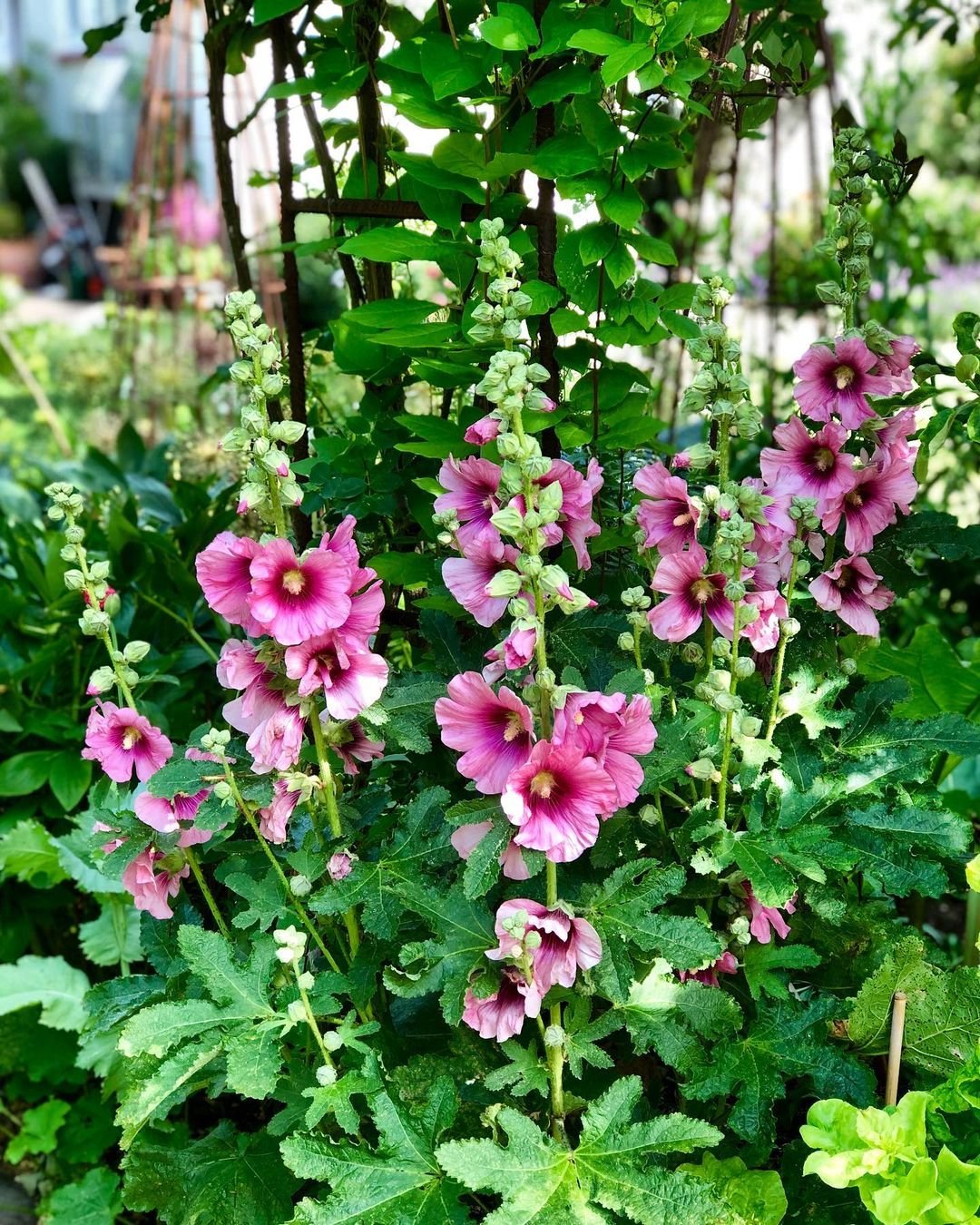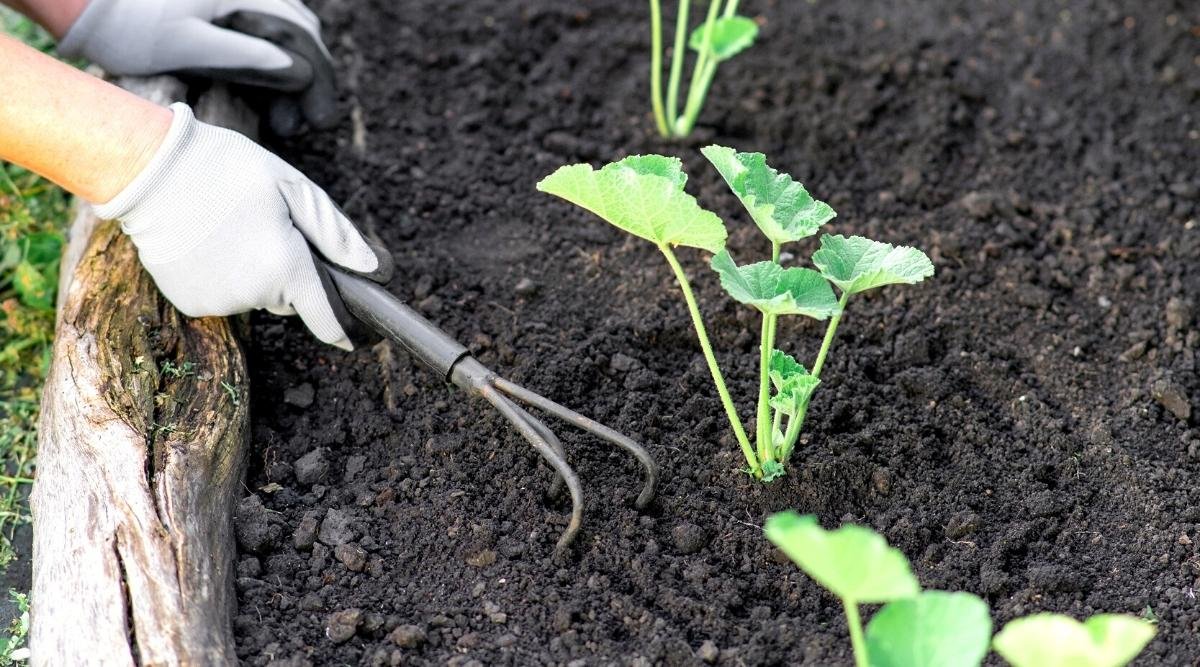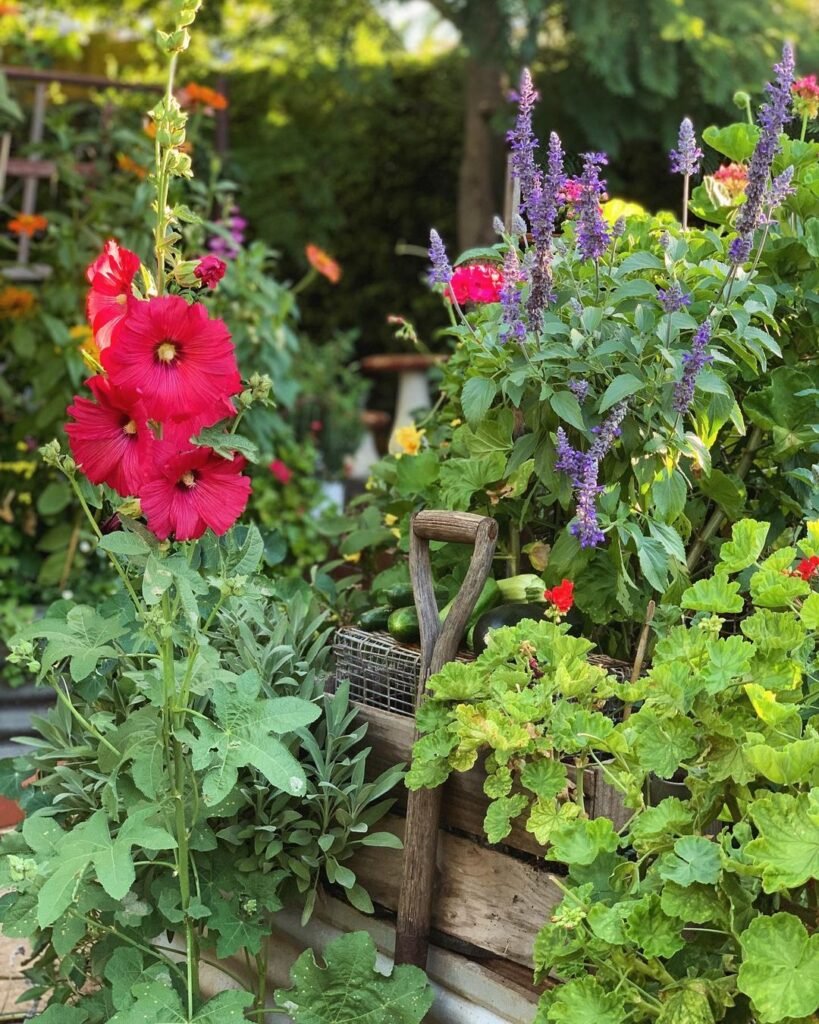Hollyhocks are classic cottage garden favorites known for their tall spires of vibrant blooms. Learn how to grow these eye-catching flowers, from planting and soil needs to care tips for keeping them healthy and prolific.
Hollyhocks are a quintessential addition to any garden, with their towering spikes of ruffled blooms in rich hues that evoke nostalgia and charm. These old-fashioned flowers have graced cottage gardens for centuries, captivating gardeners with their stately presence and undeniable beauty. Whether you’re a seasoned green thumb or a budding gardener, growing hollyhocks is a rewarding experience that will add a touch of timeless elegance to your outdoor space. In this comprehensive guide, we’ll explore everything you need to know to cultivate these stunning blooms successfully.
Getting Started with Hollyhocks

Here’s a short information chart about hollyhocks:
| Common Name | Hollyhocks |
|---|---|
| Botanical Name | Alcea rosea |
| Plant Type | Perennial |
| Zones | 3-9 |
| Exposure | Full sun to partial shade |
| Bloom Time | Late spring to early summer |
| Height/Spread | 4-8 feet tall, 1-3 feet wide (depending on variety) |
Understanding the Plant Hollyhocks (Alcea rosea) are biennials, meaning they complete their life cycle over two growing seasons. In the first year, they establish a sturdy root system and foliage, while in the second year, they produce their iconic flower spikes before setting seed and dying off. However, with proper care, hollyhocks can often self-sow, ensuring a continuous display year after year.
Choosing the Right Variety Hollyhocks come in a range of colors, including classic shades of red, pink, yellow, and white, as well as more unusual hues like purple and nearly black. Some popular varieties to consider include:
- Chater’s Double: Large, fully double blooms in a variety of colors
- Ourisienne: Single, ruffled blooms in shades of red, pink, and yellow
- Nigra: Deep maroon, nearly black blooms for a dramatic impact
Planting Hollyhocks
Site Selection

Hollyhocks thrive in full sun, requiring at least six hours of direct sunlight per day. They also prefer well-draining soil that is rich in organic matter. Avoid planting in areas with heavy, clay soils or poor drainage, as this can lead to root rot and other issues.
Soil Preparation

Before planting, amend the soil with compost or well-rotted manure to improve drainage and nutrient content. Hollyhocks appreciate a slightly alkaline soil with a pH between 6.5 and 7.5, so consider adding lime if your soil is overly acidic.
Sowing Seeds or Transplanting
Hollyhocks can be grown from seed or purchased as seedlings or young plants. If sowing seeds directly in the garden, plant them 1/4 inch deep and 12 to 18 inches apart in early spring or late fall. For transplants, space them 18 to 24 inches apart, taking care not to damage the taproot.
Caring for Hollyhocks
Watering
Hollyhocks have moderate water needs, requiring about 1 inch of water per week during the growing season. Water deeply and consistently, taking care not to overwater or allow the soil to become waterlogged, as this can lead to root rot.
Fertilizing

Apply a balanced, slow-release fertilizer in early spring and again after the first flush of blooms. Hollyhocks are heavy feeders, and proper fertilization will promote healthy growth and abundant flowering.
Staking and Support

As hollyhocks mature, their tall flower spikes can become top-heavy, making them susceptible to wind damage or breaking. To prevent this, provide support by tying the stems to sturdy stakes or installing a trellis or cage system.
Pruning and Deadheading
Regular deadheading (removing spent blooms) will encourage hollyhocks to produce more flowers throughout the season. In late fall or early spring, cut back the dead foliage to the ground to tidy up the plant and prevent disease.
Pests and Diseases

Hollyhocks are generally resilient, but they can be susceptible to issues like rust, leaf spot, and Japanese beetles. Monitor plants regularly and address any problems promptly with appropriate organic or chemical controls.
Incorporating Hollyhocks into Your Garden Design
Borders and Backgrounds

With their towering height and striking color, hollyhocks make excellent additions to borders, cottage gardens, and backgrounds. Place them toward the rear of garden beds to create a stunning vertical element.
Cut Flowers

Hollyhock blooms make beautiful and long-lasting cut flowers for indoor arrangements. Cut the stems in the morning and immediately place them in water for best vase life.
Companion Planting

Hollyhocks pair well with a variety of other cottage garden favorites, such as daylilies, foxgloves, and peonies. They also complement lower-growing plants, like lavender and catmint, creating a beautiful and harmonious display.
Conclusion
Hollyhocks are true garden treasures, capturing the essence of old-world charm and beauty. With their stately presence and vibrant blooms, they add a touch of nostalgia and timeless elegance to any outdoor space. By following the guidelines outlined in this comprehensive guide, you can successfully cultivate these stunning flowers and create a breathtaking display that will be the envy of your neighborhood. So why not embrace the timeless appeal of hollyhocks and introduce these captivating blooms to your garden today?
Pingback: How to Grow Hollyhocks: An Essential Guide for ...
Pingback: The Radiant Beauty of Yellow Mums: A Gardener’s Guide -
Pingback: A Comprehensive Guide to Calathea varieties Gardeners School
Pingback: Calathea Makoyana: How to Plant,Grow and Care for It Indoors
Pingback: Calathea Roseopicta: How to Plant, Grow and Care
Pingback: Growing a Fruitful Mango Tree: A Global Perspective -
Pingback: Prickly Pear Cactus (Opuntia): Comprehensive Guide to Caring
Pingback: Discover 18 Stunning Russian Flowers: A Visual Delight -
Pingback: 20 Types of Yucca Plants (With Pictures) -
Pingback: How to Grow and Care for a Tulip Tree (Step-by-Step Guide)
Pingback: Winter Bird Feeding: A Guide to Nourishing Our Feathered Friends
Pingback: Beauty of Maiden Grass: Your Ultimate Guide
Pingback: Caterpillars in California: Exploring the Diverse World
Pingback: Hollyhocks : How to Grow and Care for These Classic Cottage Flowers - Gardener's School
Pingback: Lilium Roselily Samantha (Double Oriental Lily) -
Pingback: Growing a Fruitful Mango Tree : A Global Perspective - Gardener's School
Pingback: Umbrella Tree: A Comprehensive Guide to Cultivation - Gardener's School
Pingback: Rio Dipladenia Care: A Comprehensive Guide -
Pingback: 10 Texas Caterpillars: A Visual Identification Guide - Gardener's School
Pingback: Foxgloves : The Complete Guide to Growing and Caring